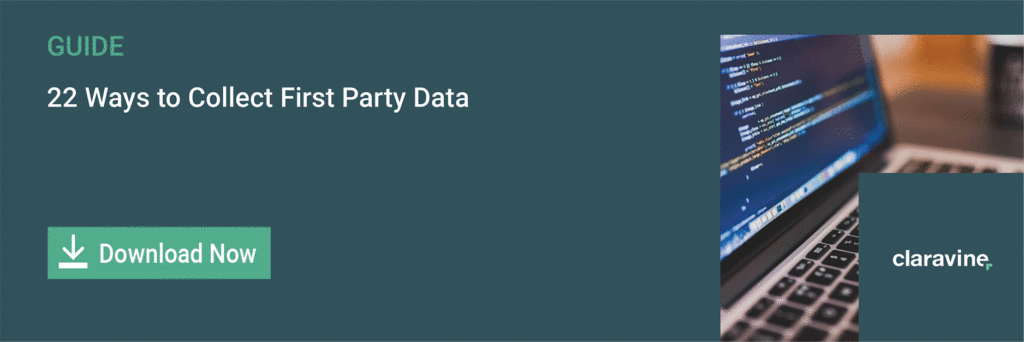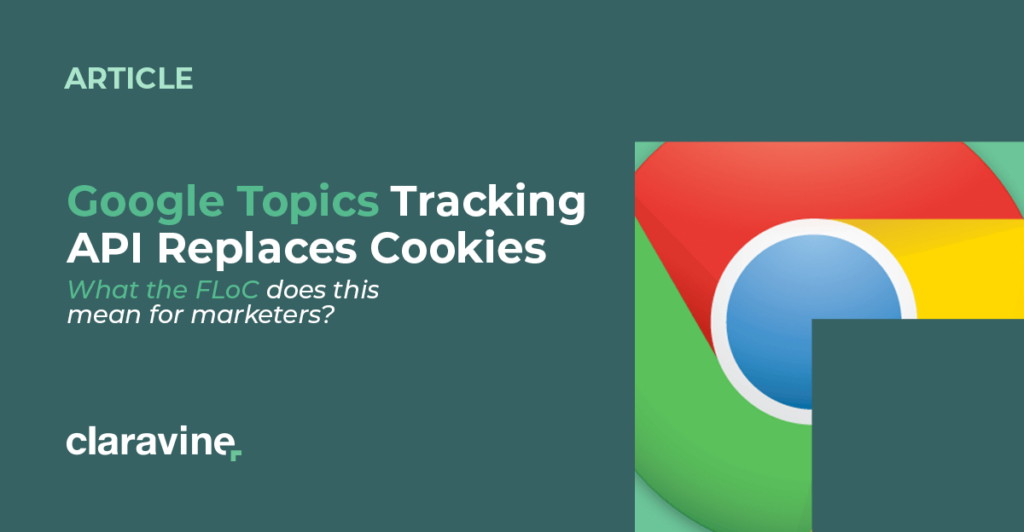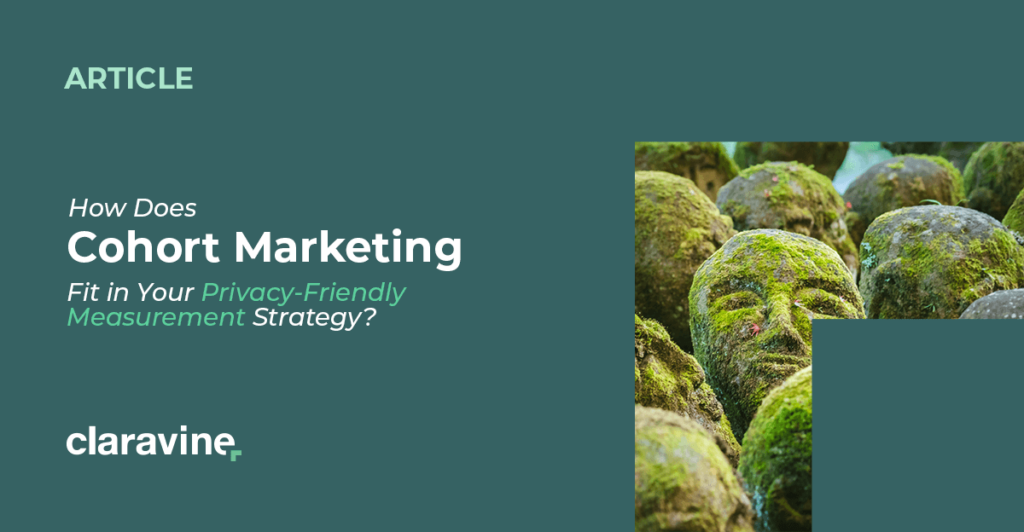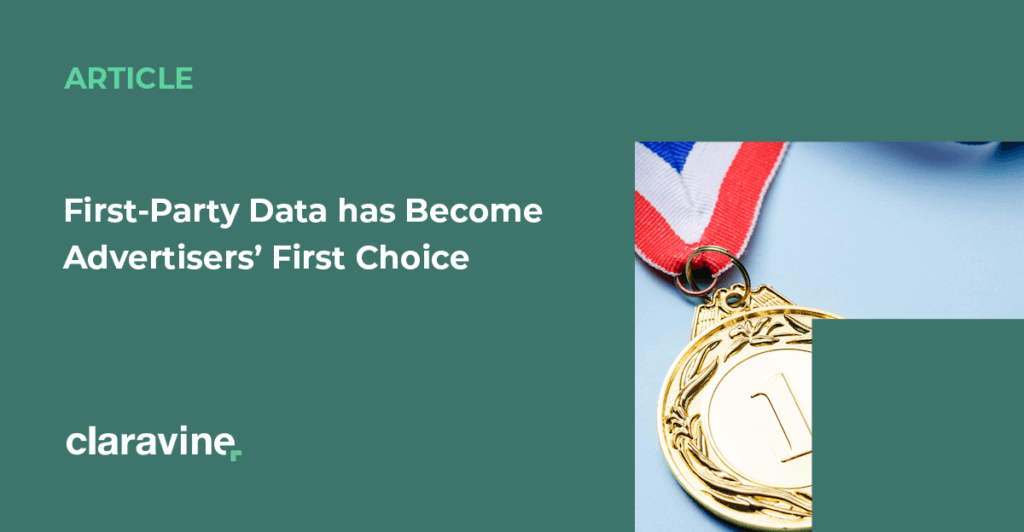Making Sense of Second Party Data with Examples and First/Third Party Data Comparisons
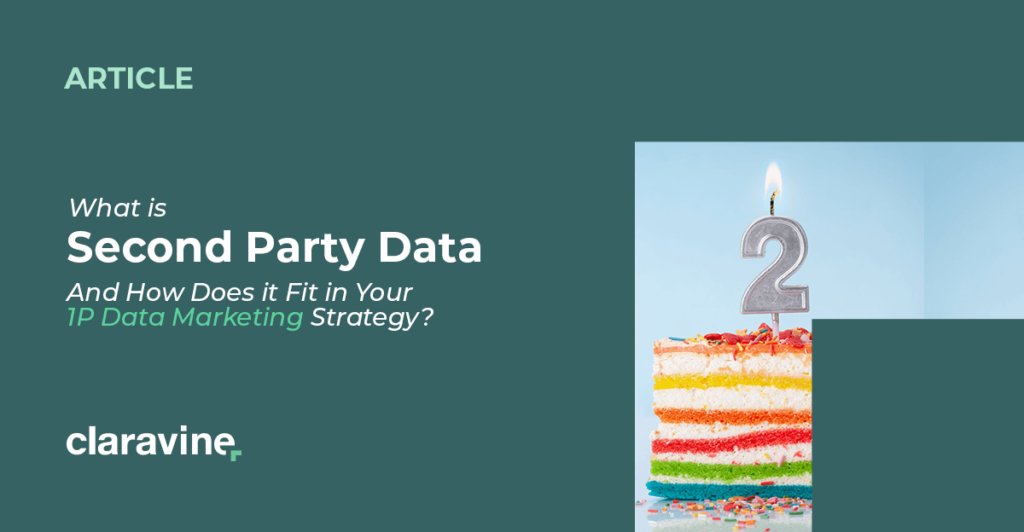
GDRP and privacy laws have upended the way brands collect and leverage data to target their audiences. As third party cookies circle the drain, brands are pursuing other ways to delve into the minds of their prospects and customers.
Collecting more first party data is the obvious choice, as Claravine’s recent first party data study relates. But while 86% of marketers recognize first party data will be vital to collect going forward, it isn’t the only way to ensure regulatory compliance and effective campaigns.
More and more brands are leveraging trusted partners’ data, or second party data, to minimize risk and provide relevant targeted customer experiences.
So while you evaluate your first party data collection and management methods, consider obtaining second party data to really supercharge your strategy.
We’ll help you get started. First, we’ll review the different types of data you can collect. Then we’ll review the advantages of second party data and why it’s an essential part of your first party strategy. Finally, we’ll touch on the importance of establishing metadata management and data standards as you solidify your data collection strategy.
You need a comprehensive understanding of your prospects and customers to maximize the effectiveness of your marketing campaigns. Let’s start by exploring the four different types of data you can collect about your audience.
Second Party Data Explained
What is Second Party Data?
Second party data is the first party data of a trusted partner who either shares your audience or whose audience you’d like to target. You can obtain second party data from a business partner, data co-ops, or you can purchase it through second party data marketplaces. You can also combine your first party data with another entity’s second party data within a neutral, privacy-controlled environment known as a data clean room, an option Gartner recommends for brands that spend over $1 billion in advertising.
Like first party data, second party data is accurate, relevant, and high quality — so long as it’s from a source whose metadata management and collection practices you can trust.
Second party data examples include social media profiles, customer feedback and surveys, website activity, and any other examples of first party data. For example, a hotel booking site could purchase an airline’s first party data to target users with ads for hotel packages to their preferred or past destinations.
While there aren’t any drawbacks to second party data, some organizations can find it challenging to migrate and integrate the new datasets, especially if the partner’s data standards are different.
What is First Party Data?
First party data is the information you collect about your prospects or customers through your website or mobile app. Since you collect, store, manage, and secure the data yourself, you can ensure data integrity and accuracy.
First party data can include email addresses, phone numbers, demographics, purchase history, loyalty program information, and more. For example, a retailer may use its first party data for retargeting customers who have purchased their tween-sized clothing in the past with a back-to-school marketing campaign.
There’s only one drawback to first party data — its limited scope. So while first party data is useful for targeting existing prospects and customers, it doesn’t provide insight into untapped markets.
What is Third Party Data?
Third party data is data that you purchase from data aggregators or companies that consolidate information from consumers’ browsing activity, social networks, media posts, quiz apps, and more. You can buy these comprehensive consumer profiles to complement your own from third party data brokers like Acxiom, Experian, Yodlee, Fiserv, and more.
The insurance industry relies heavily on third party data to reduce risk exposure. For example, insurers use geographic and weather-related data to identify areas prone to wildfires and price their homeowners policies accordingly.
The main drawback to third party data is a lack of transparency in its collection. So there are potential risks when you purchase it, including:
- Low-quality, poorly aggregated, or outdated datasets
- Integration issues with your existing data
- Data privacy breaches
In addition, third party data is widely available, so your competitors can purchase the same information.
What is Zero Party Data?
Zero party data is data a user intentionally provides to a brand as they interact with their website. It can include personal context like pronouns, purchase intentions, communication preferences, or any other personal information the visitor provides.
Arguably the most valuable of all data types, zero party data allows brands to curate an individual experience for every visitor to support authentic relationship building and a recurring revenue stream.
Here are some ways you can collect zero party data:
- Ask questions during the registration process
- Ask for communication and content preferences
- Leverage social media to gain insight into customer preferences through polls and hashtags
- Set up a customer loyalty program to gain insight into purchases
- Establish preference center for your email marketing channel (allow the subscriber to curate their newsletter)
Now there’s only one risk associated with collecting zero party data — overwhelming your prospect or customer. So don’t go overboard with your information requests.
The Advantages of 2P Data Over 3P Data
You’ll need more than first party data to effectively scale and target your marketing campaigns. Trusted partner data is your next best option. Here are seven benefits of prioritizing second party data over third party data.
Better quality data
When you know your information comes from a reliable, relevant source, you can expect better data quality. High-quality data that’s precisely tailored to your marketing objectives will fuel data-driven decisions you can trust.
Deeper targeting
Second party data provides additional insights into customer behavior and preferences to create more relevant and effective marketing campaigns while improving the overall customer experience.
Expanded reach
Just as you have extensive data about your own customers, second party data can be a treasure trove of insights into a new audience of potential customers. Leverage this information effectively and personalize your marketing efforts to earn their business.
Price flexibility
Obtaining second party data can be more cost-effective than third party data. For example, you can cut the middleman and approach a company whose audience you’d like to target and negotiate a mutually beneficial relationship. You could also explore joining a data co-op where members share consumer data through a jointly accessible data store.
If you choose a second party data marketplace, you may have the flexibility to purchase specific datasets, unlike many third party large, pre-packaged offerings.
More transparency
Second party data is collected directly by a trusted partner, so you’ll know exactly where the data came from, how and when it was collected, and the steps taken to verify its accuracy and integrity.
Less risk
With second party data, you have a clear view of data provenance, so there’s less risk of violating data privacy laws and regulations.
Competitive advantage
Second party data can give you a leg up on your competitors by providing unique information to support targeted campaigns to highly coveted audiences.
But before you seek second party data, consider following the lead of 72% of advertisers and solidify your first party data strategy first — complete with the right technology for collection and categorization (i.e. marketing taxonomy).
Second Party Data Examples
Now that we’ve detailed the benefits of second party data let’s look at how a buyer and seller can leverage it to tap into a new audience or revenue opportunity.
Second party data buyer
Let’s say you own a business that provides members-only luxury vacation rentals and travel experiences. You want to create a marketing campaign promoting three new properties on St. Maarten. First, of course, you’ll promote this new destination to your existing customer base, but you’re hoping to target new audiences too.
So you look for some opportunities to buy second party data from non-competitive businesses that attract the same caliber of clients. That leads you to purchase data from a boutique cruise line, private jet charter company, and a high-end wine club.
Second party data seller
Let’s say you run a successful business selling repurposed kitchen cabinetry and appliances from soon-to-be remodeled homes. Because you’ve invested in a great website and ecommerce store, along with a robust social media strategy for amplifying each new “kitchen rescue,” you’ve managed to collect vast amounts of data about your prospects and customers.
To create successful marketing campaigns, you’ve already leveraged your audience’s demographics, web browsing activity, purchase history, and contact information. So you decide to sell your data to non-competitive businesses like appliance sales and repair companies, general contractors, furniture galleries, kitchen designers, landscape designers, and more.
How 2P Data Supercharges Your 1P Data Strategy
Internet privacy regulations have forced brands to shift strategy and resources to collect first party data. And while first party data reveals the most precise details about your prospects and customers, you still need data from other sources to fuel growth and successful marketing campaigns.
Here’s how second party data supercharges your first party data strategy.
- Deepens your understanding of your audience: second party data provides additional trustworthy, accurate data points that help you better understand your customers’ preferences and behaviors so you can better serve them.
- Broadens your reach: second party data uncovers new audiences whose interests align with your own audience data.
- Supports better decision-making: Having more data about your audience supports strategic decision-making and provides insights into customer behavior and future intent.
- Drives the customer journey forward: second party data helps identify the best way to keep individual prospects and customers engaged and the sales cycle moving along.
- Boosts upsell and retention efforts: second party data expands your existing relationships and informs your strategies to keep current customers coming back.
- Creates a new potential revenue stream: Depending on your business and the size and quality of your data sets, selling your data could represent a new, meaningful revenue stream.
First Things First: Your 1P Data Collection Strategy
Worldwide enterprise data volume is expected to grow from 1 petabyte in 2020 to 2.02 by the end of 2022. Whatever that means for your particular business, one thing is certain — you’ll be accumulating more first party data.
So before you add second party data to the mix, your first party data collection strategy must be rock solid. Creating metadata management and data standards, complete with the right technology for collection and categorization is essential.
Once you’ve laid the foundation for extracting maximum value from your own customer data, you’ll be able to reap the benefits of incorporating trusted partner data.
Interested in getting to know your existing prospects and customers better? Learn how to collect first party data and what to do about data sprawl.





